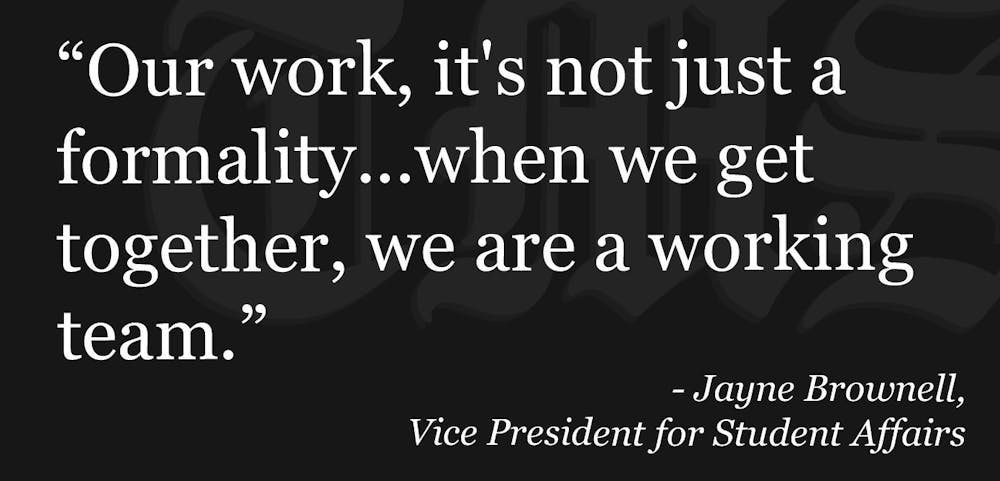When Ande Durojaiye was promoted to Miami University’s inaugural Vice President for Miami Regionals just two months after his first day as Miami’s Regional Dean, it was just the latest in a string of new VP positions on the President’s Executive Cabinet (PEC).
PEC members are well-paid. As the highest administrative staff on campus, they oversee the university’s major operations and implement far-reaching decisions.
And over the past five years, the number of high-paying cabinet positions has grown.
Since 2017, the PEC has seen the elevation of the titles assistant or associate vice president to VP for three roles, and the creation of two new VP positions. Marketing and communications, institutional diversity and inclusion, and ASPIRE (director of government relations) were elevated. The VP for Miami Regionals and the VP for research and innovation were created.
The VP for research and innovation is currently vacant.
The cabinet now sits at 15 members excluding the vacancy — President Greg Crawford, Provost and Executive VP Jason Osborne, two senior VPs, seven VPs and four additional positions.
But this expansion isn’t as expensive as it may seem.
In an email to The Miami Student, Crawford wrote that decisions regarding new positions in the PEC are decided collaboratively.
“Our work on the cabinet is far-ranging and far-reaching but always centered on Miami’s commitment to student success,” Crawford wrote. “When positions open for members of PEC, we typically have search committees composed of faculty, staff and students to help make decisions about which candidates are the best fit for Miami.”
In Durojaiye’s case, Crawford wrote that the new VP position was added to better integrate Miami’s regional campuses at an administrative level.
“The makeup of the PEC itself reflects university priorities and our overarching organizational structure,” Crawford wrote. “ … [The VP of Miami Regionals] will help Miami better integrate all of our campuses and provide opportunities to better serve our students and those communities in which our campuses reside.”
Durojaiye himself said his new position as a VP ensures that Miami’s regional campuses are considered in administrative decisions.
Enjoy what you're reading?
Signup for our newsletter
“We have these regional campuses that provide a lot — they're part of our overall larger One Miami framework,” Durojaiye said. “So how do we make sure that the voices of our faculty, our staff, our students at the regional [are] also adequately heard? I think that was the conversation or the impetus for why we decided to move in this direction.”
Despite the PEC’s intentions, a recent post by the Miami chapter of the American Association of University Professors (AAUP) Advocacy Chapter criticized the growth of the “high-paid executive tree” at Miami.
“Overgrowth at the top while the roots are cut bare — who’s served by this?” the AAUP post read, referring to full-time faculty laid off in 2020. “Not Miami students.”
Durojaiye argued that his position is a step in the right direction for the university.
“This opportunity gives us a chance to make sure that our regional voice is heard and make sure that our regional voice is at the decision making table,” Durojaiye said. “ … I definitely understand the concerns, and I definitely understand where [the AAUP is] coming from with that, I think this [position] is unique to say that anybody who's committed to One Miami would recognize there is value in making sure that our regional campuses are represented.”
The AAUP post said the expense of a growing PEC could better serve students by going toward job security and benefits for professors, but David Creamer, treasurer and senior vice president for finance and business services, said the cabinet doesn’t have a monopoly on high-paid positions.
“It’s not uncommon for deans or even some faculty positions to earn more than some members of the President’s Cabinet, because they’re not always the highest paid individuals at the institution,” Creamer said.
According to data compiled by The Buckeye Institute, which publishes salary data for Ohio’s public universities, 15 Miami employees made over $300,000 in 2019. Of those, four were professors, four were deans, four were PEC members (including Crawford) and three were coaches.
The four professors had the lowest combined take-home of just less than $1.32 million, $6,000 less than the deans and $42,000 less than the coaches. The PEC members, by comparison, had a combined salary of $1.67 million, which accounted for just less than 30% of the total.
Overall, the four highest-paid professors took home 80% of what the four highest paid PEC members made.
Head Football Coach Chuck Martin took home the highest salary, nearly $45,000 more than President Crawford, a trend Creamer said is common at other universities.
Creamer added that despite the growing number of VPs at Miami, the PEC is still in line with what’s expected for administrations in higher education.
“I've worked for five presidents in this role in other institutions,” Creamer said. “There's always some slight administrative differences, but the roles tend to be carried out similarly.”
Jayne Brownell, VP for Student Affairs, agreed.
“I came from another school seven-and-a-half years ago, [and] all of these positions were on cabinet,” Brownell said. “In fact, there are still positions at that other school that we don't have, or are divided up in different ways. [The positions at Miami] are pretty standard to have on a president's cabinet.”
At Ohio University, a similarly sized institution, the President’s Council sits at 13 members, in line with Miami’s 14. Meanwhile, Bowling Green State University counts 19 cabinet members with additional positions including health and wellness and faculty affairs.
“Our work, it's not just a formality,” Brownell said. “When we get together, we are a working team.”
During the height of the pandemic, the PEC met twice weekly. After catching up with other members on business and personal matters, Brownell said the meetings follow an agenda sent out in advance and made up of items sent to Crawford in advance by the members.
For certain projects, Brownell said unofficial subcommittees may form. For example, the COVID Response Team is made up of a flexible group of PEC members and other university and community officials who come on as needed to make big decisions, while Brownell helps with a separate COVID planning team focused on the university’s day-to-day operations regarding the pandemic.
More than decision-making and planning, though, Brownell said the PEC provides a support system for herself and her colleagues in administrative positions.
“It wouldn't be fair for me to come and vent or share that I had a hard day with people who report to me,” Brownell said. “That's not fair to them. As colleagues on [the PEC], we're the people who we can lean on because we all are in similar roles and understand the pressures and the rewards.”
Correction: This story has been updated to reflect that aside from VP of Regionals and VP of institutional research, other AVP positions that have been promoted to VP were all held by people that were already on the President’s Executive Cabinet. There are only two new VP positions that have been created.




